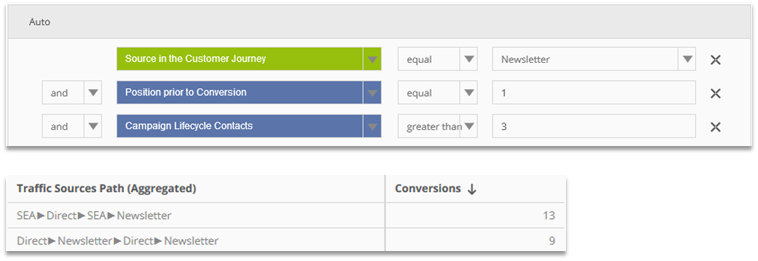Analyses 3 – Campaign Analyses
This training chapter explains how to analyze your campaigns with Mapp Intelligence.
You can also find a course on campaigns at Mapp Academy. Log in and search for "Mapp Intelligence - Campaign Analyses".
Preface
In this document, many examples for meaningful campaigns are shown.
The following default setup is used: 4 or 5 hierarchical campaign categories with the following labels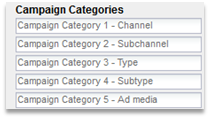
In the examples individually set up metrics are used, too, which have to be created in the formula editor. These are marked with a star ("*").![]()
1 Basics of the Configuration
In order to analyze campaigns in a meaningful way, an understanding of the basic configuration and operation is necessary.
1.1 Attribution
Usually, a specific website goal has to be reached via campaigns (e.g. order, account registration, newsletter registration).
- Which campaign is responsible for the reach of the website goal?
Different models – so called "attributions" – are supported. - Which attribution model is to be used by default?
Mapp Q3 > Configuration > Marketing Configuration > General Settings > Default Attribution
Example for 2 different attributions:

a) The first campaign (SEA) is responsible for the reach of the website goal (Newsletter registration).
b) The last campaign (Direct) is responsible for the reach of the website goal (Newsletter registration).
| Detailed information about attribution models can be found in the training chapter Campaign Configuration. |
|---|
Mapp uses the default attribution when dimensions and metrics from the sections E-Commerce and Campaigns are combined or filtered.

| Reading Example | |
|---|---|
| Qty Orders | With the 2,807 orders, the channel "SEO" won because of the defined default attribution. |
In case you set up several website goals, you need to filter by the required website goal or use separate metrics per goal (e.g. number of orders, number of newsletter registrations).![]()
1.2 API to Newsletter Tools
Data coming from newsletter tools can be imported into Mapp Intelligence via campaign categories. This can be relevant for the evaluation of newsletter campaigns.
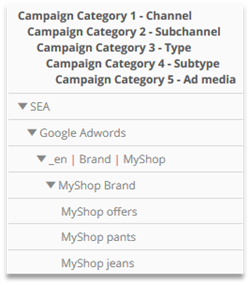
For example, the following metrics can be imported automatically:
- Delivery Rate
- Opening Rate
- Costs
1.3 API to Google AdWords
Mapp Intelligence provides an API for automatic measurement and data import from Google Ads.
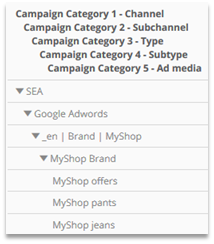
Mapp Q3 > Configuration > Interfaces > Google AdWords

The campaign categories in Mapp are matched with the respective layers of the Google Ads campaign via the interface configuration. We recommend setting up a campaign tree consisting of at least 5 levels in order to fully match the Ads layers.
For all ad types, ads and keywords the following metrics can be imported automatically:
- Clicks
- Impressions
- Costs
- Average Position
- CTR
- Campaign Cost Sales Relation
| Extended information about the configuration of the API to Google Ads can be found in the training chapter Setting Up Google Ads API. |
|---|
2 Campaign Analyses
The analysis of campaigns is usually done in the campaign tree, which displays all marketing campaigns in a structured way.
Only clicked campaigns are depicted.
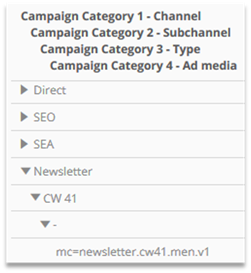
2.1 Campaign Analyses for Shops
The following metrics allow a detailed evaluation of revenue and orders.
Analysis: Individual Analysis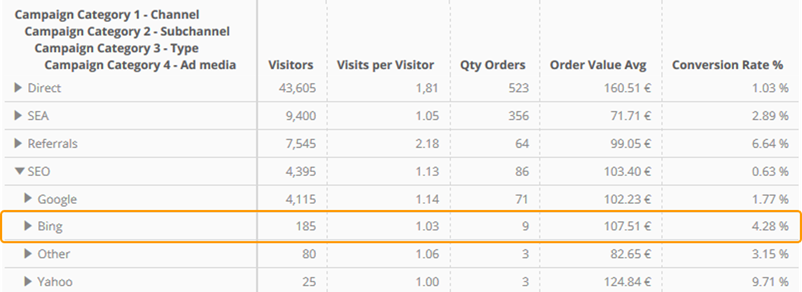
| Reading Example | |
|---|---|
| Visitors | 185 users accessed the website via the unpaid Bing search. |
| Visits per Visitor | On average 1.03 visits were made by users that came to the website via the unpaid Bing search. |
| Qty Orders | 9 orders were matched with the unpaid Bing search according to the attribution model. |
| Order Value Avg | On average 107.51 € were generated per order by users, that came to the website via the unpaid Bing search. |
| Conversion Rate % | 4.28 % of all users, that came to the website via the unpaid Bing search, made a purchase. |
| All E-Commerce metrics (in the example Conversion Rate %, Qty Orders, Order Value Avg) were calculated based on the default attribution. |
|---|
How did accesses to campaign channels change compared by time periods?
Analysis: Marketing > Campaign Categories > [Name of the campaign channel] > Comparison
| Reading Example | |
|---|---|
| Visitors – Previous Month | 905 visitors used the channel Affiliate in the last month. |
| Visitors – Previous Month / Cal. month before previous month | In the last month, 44.31% less visitors used the channel Affiliate than in the month before. |
| Conversion rate % – Previous month | 11.60% of all visitors ordered in the last month. |
| Conversion rate % – Previous month / Cal. Month before previous month | In the last month, the conversion rate was 7.75% lower than in the month before. |
Via which campaign channels do my most lucrative customers access the website?
Analysis: Individual Analysis

| Reading Example | |
|---|---|
| Visitors | 199,314 users from the group of Big Spenders came via the SEA channel. |
| Campaign Clicks | They generated 265,858 campaign clicks. |
| Qty Orders | 8,859 orders were matched according to the attribution model. |
| Conversion Value | The orders had a value of 509,376.12 €. |
| The segment "Big Spenders" is based on the RFM model, which has to be configured individually. |
|---|
What is the performance of Google Ads campaigns?
Analysis: Individual Analysis
| Reading Example | |
|---|---|
| Visits | In 3.489 visits the website was accessed via the ad "MyShop offers", which belongs to the Google Ad Group "MyShop Brand" of the Google Ads campaign "_en | Brand | MyShop". |
| Conversion Rate % | 1,72 % of all users, that accessed the website via the ad, also made a purchase. |
| Order Value | These purchases had a total order value of 2,223.00 €. |
| Campaign CPO | The costs per order (CPO) were at 5.23 €. This is based on the costs, that are imported via the Google Ads API. |
| Campaign Cost Sales Relation % | The campaign costs for this ad amount to 7.11 % of the revenue, that is generated with it. This is based on the costs, that are imported via the Google Ads API. |
| Share of New Customer Orders %* | 25.36 % of the orders, that were generated by the ad, were placed by new customers. |
Which campaign channels led to a purchase in which product category?
Analysis: Individual Analysis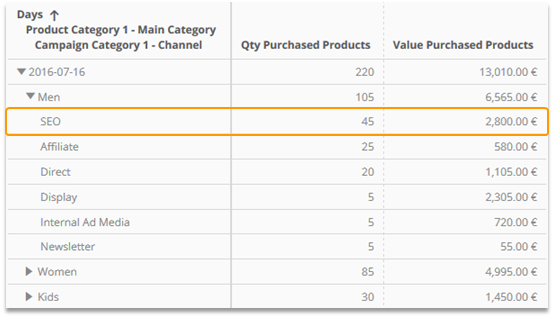
| Reading Example | |
|---|---|
| Qty Purchased Products | 45 products from the main category "Men" were purchased via the channel "SEO" on 2016-07-16. |
| Value Purchased Products | 2,800.00 € product revenue was generated in the main category "Men" via the channel "SEO" on 2016-07-16. |
Which products were viewed via SEA campaigns, added into the shopping cart, and purchased?
Analysis: E-Commerce > Products

| Reading Example | |
|---|---|
| Qty Product Views | The product "66458_Toaster" was viewed 6,561 times when the visitors accessed the website via the channel "SEA". |
| Add to Shopping Cart Rate % | In 25,68 % of these product views the product was also added to the shopping cart. |
| Product Conversion Rate % | 14,04 % of these product views led to the purchase of the product. |
| Qty Purchased Products | The product was purchased 921 times. |
| Value Purchased Products | The purchased products had a total value of 33,156.00 €. |
For which order numbers was the campaign channel SEA responsible?
Analysis: Individual Analysis

| Reading Example | |
|---|---|
| The Order ID "186974570" was placed on 2016-11-20 at 08:51:19 and had an Order Value of 304.00 €. The visitor accessed the website via the channel "SEA". |
What is the performance of newsletter campaigns?
Analysis: Individual Analysis
| Reading Example | |
|---|---|
| Visits | The newsletter campapign "mc=newsletter.cw41.men.v1" led to 17,845 orders on the website. |
| Campaign Clicks per Visit* | The campaign link was accessed 1.41 times per visit on average. |
| CTR Website Access to Recipients %* | 17.01 % of the newsletter‘s recipients accessed the website. |
| Conversion Rate % | 3.03 % of the users, that accessed the website via the newsletter, also made a purchase. |
| Orders with Advertised Product Rate %* | 53.88 % of the orders of visitors, that accessed the website via the newsletter, also included the product advertised in the newsletter. |
| Bounce Rate % | In 75.41 % of the visits generated by the newsletter, only one single page was accessed. |
| Unsubscription Rate %* | 6.93 % of the newsletter‘s recipients unsubscribed from future newsletter reception. |
What does the order process of SEA users look like?
Analysis: Navigation > Processes 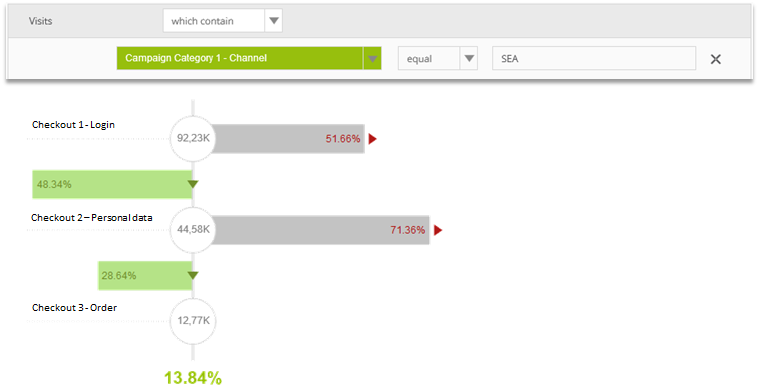
| Please note the scope "Visit" at the filtering. |
|---|
What long-term revenue was generated with newly won customers per campaign channel?
Analysis: Marketing > Campaign Categories > [Name of the Campaign Channel]
| Reading Example | |
|---|---|
| URM - Campaign New Visitor CLV | 158,417.50 € of total order value was generated by new customers via the channel "SEO" until today. |
| Conversion Value | 486,307.50 € of order value was matched with the channel "SEO" based on the attribution model. |
2.2 Campaign Analyses for Content Sites
The following metrics are frequently used by content sites.
Analysis: Individual Analysis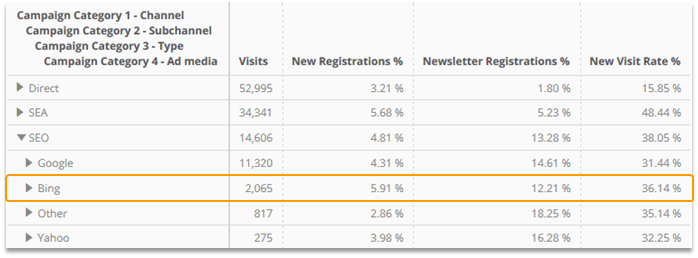
| Reading Example | |
|---|---|
| Visits | 2,065 visits were made via the unpaid Bing search. |
| New Registrations %* | 5.91 % of all users, that accessed the website via the unpaid Bing search, also made a registration. |
| Newsletter Registrations %* | 12.21 % of all users, that accessed the website via the unpaid Bing search, also registered for the newsletter. |
| New Visit Rate %* | 36.14 % of all visits were made by new visitors. |
| All metrics referring to website goals (in the example this would be New Registrations % and Newsletter Registrations %) are calculated according to the default attribution. |
|---|
How did accesses to campaign channels change compared by time periods?
Analysis: Marketing > Campaign Categories > [Name of the campaign channel] > Comparison
| Reading Example | |
|---|---|
| Visitors – Last Week | 5.865 Visitors used the channel SEO in the last week. |
| Visitors – Last Week / Cal. week 2 weeks ago | In the last week, 61,35 % more visitors used the channel SEO than in the week before. |
| Visit Duration Avg – Last Week | On average, a visit lasted 58 seconds in the last week. |
| Visit Duration Avg – Last Week / Cal. week 2 weeks ago | In the last week, the visit duration was 18,23% lower than in the week before. |
Via which campaign channels come visitors, that are frequently on the website?
Analysis: Individual Analysis
| Reading Example | |
|---|---|
| Visitors | 199,314 visitors from the group "Frequent Users" came via the SEA channel. |
| Campaign Clicks | They generated 265,858 campaign clicks. |
| The segment "Frequent Users" is based on the RFE model, that has to be configured individually. |
|---|
What is the performance of Google Ads campaigns?
Analysis: Individual Analysis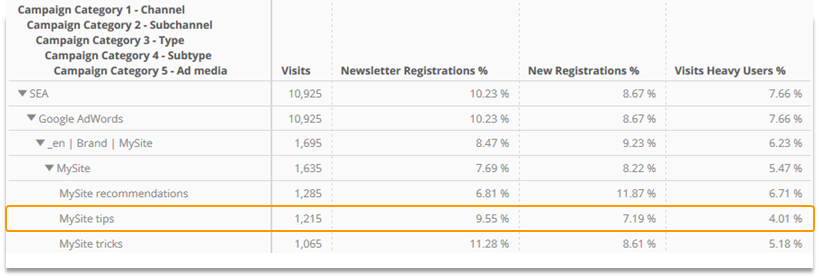
| Reading Example | |
|---|---|
| Visits | In 1,215 visits the website was accessed via the ad "MySite tips", which belongs to the Google Ad Group "MySite" of the Google Ads campaign "_en | Brand | MySite". |
| Newsletter Registrations %* | 9.55 % of the users, that accessed the website via this ad, did also sign up for the newsletter. |
| New Registrations %* | 7.19 % of the users, that accessed the website via this ad, did also sign up for an account on the website. |
| Visits Heavy Users %* | 4.01 % of the visits generated by the ad were made by particularly active users. |
What is the performance of the newsletter campaigns?
Analysis: Individual Analysis
| Reading Example | |
|---|---|
| Visits | The newsletter campaign "mc=newsletter.cw41.events.v1" led to 68,412 visits on the website. |
| Campaign Clicks per Visit* | The campaign link was accessed 1.82 times per visit on average. |
| CTR Website Access to Recipients %* | 16.28 % of all newsletter recipients also accessed the website. |
| Reactivation of inactive User %* | 17.63 % of all users, that accessed the website via the newsletter, were not active on the website recently. |
| Event registration %* | 4.72 % of all users, that accessed the website via the newsletter, also signed up for an event. |
| Bounce Rate % | In 79.13 % of all visits generated by the newsletter only one single page was accessed. |
| Unsubscription rate %* | 7.78 % of the newsletter recipients unsubscribed from further newsletter reception. |
What does the registration process of SEA users look like?
Analysis: Navigation > Processes
| Please note the scope "Visit" at the filtering. |
|---|
2.3 Campaign Type
Every page, that is accessed after a campaign, is matched with the respective campaign.
By using the campaign type it is possible to differentiate between:
- Clicks: When the data source of the campaign (e.g. media code) is tracked.
- Engagement: All page accesses between campaign click and conversion.
- Conversion: A website goal is reached and the campaign complies with the default attribution.
Optional:
- Viewed: Only available, when campaign views are imported.
- Offline: Only available, when offline orders are tracked via a separate offline pixel.

| The campaign type is only available for campaigns, that are acknowledged in an attribution model. The chosen default attribution solely affects the campaign, which is matched with the campaign type "Conversion". |
|---|
On which pages accesses via newsletter campaigns were measured?
Analysis: Navigation > Pages > Pages

Which pages were measured after the newsletter landingpage in the course of the visit?
Analysis: Navigation > Pages > Pages

Which pages were used directly after the landing page of the newsletter campaign?
Analysis: Navigation > Pages > Follower Pages

3 Customer Journey
All campaigns until the reach of a website goal are saved in a Customer Journey.

- Only campaigns, that helped to reach a website goal, are analyzed.
- Customer Journeys work independently from attribution models.
This means, that all campaign contacts are analyzed, which were used by a visitor within 30 days prior to the reach of a website goal. - A maximum amount of 15 campaign contacts are measured.
If there are more contacts, the first one and the last 14 are saved.
If you have set up several website goals, you need to filter the Customer Journey analyses by the respective goal or use separate metrics per goal (e.g. number of orders, number of newsletter registrations).
Example of Customer Journeys with several website goals

Customer Journeys are saved at the reach of a website goal. Therefore, they can‘t be filtered or matched with other dimensions or metrics freely.
A combination of the following dimensions is supported:
- Website Goal
- Order ID
- [Campaign Category | Source | Campaign Parameter | Ad Media] in the Customer Journey
- Internal/External Campaign in the Customer Journey
- Search Phrases (Campaigns)
- Device Class in the Customer Journey
- SEA keywords in Customer Journey
- Position in Campaign Lifecycle, Position prior to Conversion
- Time in Campaign Lifecycle (Days)
- Campaign Lifecycle Contacts
- The number of contacts in the Customer Journey. E.g. "0, 1,…"
- Time in Campaign Lifecycle
- Shows the contact point in the Customer Journey. E.g. "2016-07-01 16:04:39"
3.1 Customer Journey Analyses
On which position is the campaign used, that is involved in the reach of a website goal?
Analysis: Individual Analysis
| Reading Example | |
|---|---|
| Campaign Lifecycle Contacts | The traffic source "Newsletter" was measured 51,990 times within a Customer Journey. |
| Conversion Initiator % | At 2.26 % of all contacts it was the first contact within the Customer Journey. |
| Conversion Supporter % | At 2.78 % of all contacts it was neither the first nor the last contact within the Customer Journey. |
| Conversion Transformer % | At 94.96 % of all contacts it was the last contact within the Customer Journey. |
| Position in Campaign Lifecycle % | 91.00 % of the Customer Journey was over, when the traffic source "Newsletter" was measured. |
| Time prior to Conversion Avg (Impulse Conversion) | On average 2 hours, 2 minutes and 27 seconds went by between the access of the newsletter and the conversion. |
In what order are campaigns accessed prior to the reach of a website goal?
Analysis: Marketing > Customer Journeys > Ad Media Path
| Reading Example | |
|---|---|
| Conversions | At 39 conversions the ad media "Google Adwords.Brand.Fall16.Newborn" was used first and "Direct" after it. |
| Conversion Value | A conversion value of 735.30 € was generated, when the ad media "Google Adwords.Brand.Fall16.Newborn" was clicked first and then "Direct" was used. |
What do Customer Journeys look like, when a newsletter campaign was involved in them?
Analysis: Marketing > Customer Journeys > Traffic Sources Path (Aggregated)
| In the "Aggregated" analyses the subsequent contacts of the same campaign are only depicted once (Newsletter > Newsletter > Direct is transformed into Newsletter > Direct). |
|---|
What do Customer Journeys look like, in which courses the first campaign contact was a SEA campaign and an order was placed?
Analysis: Marketing > Customer Journeys > Traffic Sources Path
What do Customer Journeys look like, in which courses the last campaign contact was a newsletter campaign, and more than 3 campaigns were used?
Analysis: Marketing > Customer Journeys > Traffic Sources Path (Aggregated)